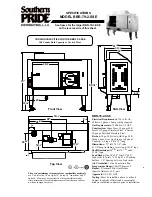
16
Low-Impedance vs. 70V/100V Speakers
Control Contractor ceiling speakers come in low-impedance (“non-T”) and 70V/100V (“T”) versions.
There are different types of power amplifiers for driving each of these types of speakers. Make sure to use
the correct amplifier type specifically designed to drive the type of speaker you are using.
Low Impedance (8
Ω
to 16
Ω
) Speakers
•
Low impedance speakers have a direct connection from the power amplifier, resulting in more
efficient transfer of power for short and medium cable runs. There is no input transformer on the
speaker and the amplifiers don’t have output transformers, each of which can reduce the total
power delivered to the speakers.
•
Low impedance speakers often provide higher headroom, both within the speaker and from the
amplifier.
•
Low impedance speakers provide greater output level because of not being limited by the power
tap setting of a 70V/100V speaker.
Impedance Considerations – The impedance of the Control 24C and Control 26C is 16 ohms,
NOT 8 ohms as is typical of most ceiling speakers. It is important to NOT present a lower
impedance load to the amp than the amp is capable of handling. The 16 ohm impedance allows
connection of more speakers on each channel of an amplifier. Many low-impedance amplifiers
accept loads of 4 ohms or 2 ohms. It is possible to connect as many as four (4) Control 24C or
Control 26C speakers in parallel to each channel of a 4-ohm-capable amplifier, and as many as eight
(8) speakers in parallel to each channel of a 2-ohm-capable amp.
By using a 2-ohm-capable amp, it is possible to connect a sixteen (16) speaker stereo system, eight
(8) speakers per channel, without having to use 70V/100V speakers.
The Control 19CS subwoofer is different from the other models in that it is 8 ohms, not 16 ohms. In
this way, it can get as much power as possible from the power amplifier, even when only one (1) or
two (2) subwoofers is utilized.
Formulas for Parallel Speakers:
When speakers are the SAME impedance as each other:
T = R/N
T is the total impedance
R is the impedance of a single speaker
N is the number of speakers
When Speakers are DIFFERENT Impedances:
T = 1 / (1/R
1
+ 1/R
2
+ 1/R
3
. . . )
T is the total impedance
R
1
, R
2
, R
3
are the impedances of the individual speakers (include all speakers)
70V/100V Speakers:
•
70V/100V speakers are a good choice if you are using so many speakers that the impedance would
be too low for a low-impedance amplifier to drive.
•
70V/100V speakers allow individual adjustment of the level of each speaker up or down (using the
tap selector switch).
•
70V/100V speakers are often easier to configure into systems with complex zoning and level
control requirements.
•
70V/100V lines can transfer power more effectively using considerably smaller gauge speaker
cables, which can result in significant cost savings on longer cable runs.
•
The Control Contractor’s 70V/100V transformers are of a very good quality, where they do not
saturate easily at low frequencies. With other brands of speakers, transformer saturation from
inexpensive transformers or autoformers can cause unpleasant distortion at all levels and often
prevents operating the speakers below 100 Hz.





































